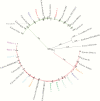Clinical and Genomic Characterization of Recurrent Enterococcal Bloodstream Infection in Patients With Acute Leukemia
- PMID: 29977964
- PMCID: PMC6016419
- DOI: 10.1093/ofid/ofy107
Clinical and Genomic Characterization of Recurrent Enterococcal Bloodstream Infection in Patients With Acute Leukemia
Abstract
Background: Rates and risk factors for recurrent enterococcal bloodstream infection (R-EBSI) and whether the same genetic lineage causes index EBSI and R-EBSI are unknown in patients with acute leukemia (AL) receiving chemotherapy.
Methods: Ninety-two AL patients with EBSI from 2010 to 2015 were included. Enterococcal bloodstream infection was defined by 31 positive blood cultures for Enterococcus faecium or Enterococcus faecalis and fever, hypotension, or chills. Clearance was defined by 31 negative cultures 324 hours after last positive culture and defervescence. Recurrent enterococcal bloodstream infection was defined by a positive blood culture for Enterococcus 324 hours after clearance. Categorical variables were reported as proportions and compared by the χ2 test. Continuous variables were summarized by median and interquartile range (IQR) and compared by the Wilcoxon-Mann-Whitney Test. P values <.05 were considered significant. Whole-genome sequencing was performed on available paired BSI isolates from 7 patients.
Results: Twenty-four patients (26%) had 31 episodes of R-EBSI. Median time to R-EBSI (IQR) was 26 (13-50) days. Patients with R-EBSI had significantly longer durations of fever and metronidazole exposure during their index EBSI. Thirty-nine percent of E. faecium R-EBSI isolates became daptomycin-nonsusceptible Enterococcus (DNSE) following daptomycin therapy for index EBSI. Whole-genome sequencing analysis confirmed high probability of genetic relatedness of index EBSI and R-EBSI isolates for 4/7 patients.
Conclusions: Recurrent enterococcal bloodstream infection and DNSE are common in patients with AL and tend to occur within the first 30 days of index EBSI. Duration of fever and metronidazole exposure may be useful in determining risk for R-EBSI. Whole-genome sequencing analysis demonstrates that the same strain causes both EBSI and R-EBSI in some patients.
Keywords: Enterococcus; acute leukemia; daptomycin-nonsusceptible Enterococcus; recurrent bloodstream infection; whole-genome sequencing.
Figures

Similar articles
-
Comparison of clinical outcomes and risk factors in polymicrobial versus monomicrobial enterococcal bloodstream infections.Am J Infect Control. 2016 Aug 1;44(8):917-21. doi: 10.1016/j.ajic.2016.02.017. Epub 2016 Apr 11. Am J Infect Control. 2016. PMID: 27079241
-
Genetic relatedness and risk factor analysis of ampicillin-resistant and high-level gentamicin-resistant enterococci causing bloodstream infections in Tanzanian children.BMC Infect Dis. 2015 Feb 28;15:107. doi: 10.1186/s12879-015-0845-8. BMC Infect Dis. 2015. PMID: 25884316 Free PMC article.
-
Clinical Characteristics And Risk Factors In Mixed-Enterococcal Bloodstream Infections.Infect Drug Resist. 2019 Oct 31;12:3397-3407. doi: 10.2147/IDR.S217905. eCollection 2019. Infect Drug Resist. 2019. PMID: 31802919 Free PMC article.
-
The Global Prevalence of Daptomycin, Tigecycline, and Linezolid-Resistant Enterococcus faecalis and Enterococcus faecium Strains From Human Clinical Samples: A Systematic Review and Meta-Analysis.Front Med (Lausanne). 2021 Sep 10;8:720647. doi: 10.3389/fmed.2021.720647. eCollection 2021. Front Med (Lausanne). 2021. PMID: 34568377 Free PMC article.
-
Treatment options for vancomycin-resistant enterococcal infections.Drugs. 2002;62(3):425-41. doi: 10.2165/00003495-200262030-00002. Drugs. 2002. PMID: 11827558 Review.
Cited by
-
Comparative genomic analysis of clinical Enterococcus faecalis distinguishes strains isolated from the bladder.BMC Genomics. 2023 Dec 7;24(1):752. doi: 10.1186/s12864-023-09818-z. BMC Genomics. 2023. PMID: 38062354 Free PMC article.
References
-
- Ford CD, Lopansri BK, Haydoura S, et al. . Frequency, risk factors, and outcomes of vancomycin-resistant Enterococcus colonization and infection in patients with newly diagnosed acute leukemia: different patterns in patients with acute myelogenous and acute lymphoblastic leukemia. Infect Control Hosp Epidemiol 2015; 36:47–53. - PubMed
-
- Ornstein MC, Mukherjee S, Keng M, et al. . Impact of vancomycin-resistant enterococcal bacteremia on outcome during acute myeloid leukemia induction therapy. Leuk Lymphoma 2015; 56:2536–42. - PubMed
Grants and funding
LinkOut - more resources
Full Text Sources
Other Literature Sources
Molecular Biology Databases

